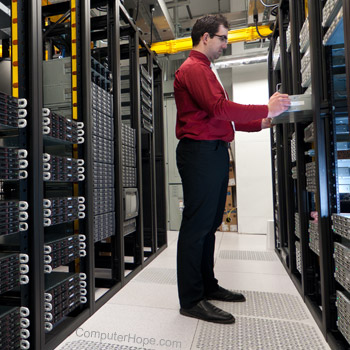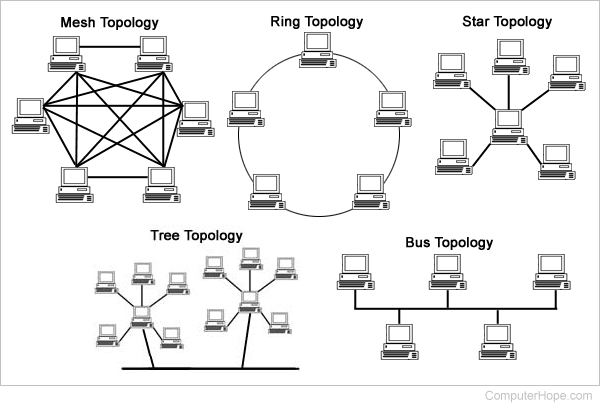Network

A network is a collection of computers, servers, mainframes, peripherals, or other devices connected to facilitate communication and data sharing. Essentially, it is a system that allows two or more devices to exchange information, resources, and services.
You can think of a network like a spider web. The transmission lines (analogous to webbing) connect each hardware device (sometimes called nodes). Networks can contain as few as two devices or be as large as the Internet, which connects billions of people all over the world. The image shows a technician working in a server room, an example of an area where network devices are stored.
Networking was featured as a top term in 1992.
The following sections contain useful information about networks that we hope you find useful. We recommend checking out each section individually if you're new to networks. Otherwise, you can use the list below to skip to specific topics.
Examples of network devices
The following list contains many devices used with or connected by networks.
- Desktop computers, laptops, mainframes, and servers.
- Consoles and thin clients.
- Firewalls
- Bridges
- Repeaters
- Network Interface cards
- Switches, hubs, modems, and routers.
- Smartphones and tablets.
- Webcams
Network topologies
Network topology refers to the order network devices connect and how they're arranged spatially. More plainly, topology describes the layout of a network and its connected devices. Typical network configurations include mesh topology, ring topology, star topology, tree topology, bus topology, and hybrid topology (a mix of topologies).
The image below contains geometric depictions of the aforementioned network topologies. Devices are represented as vertices, and their connections are represented as edges on the graph. These examples show how many connections each device has and their respective order and hierarchy.

Most home networks are configured using a tree topology that connects to the Internet. Corporate networks often use tree topologies, but incorporate star topologies and an Intranet for security and internal communication purposes.
Why are networks necessary?
Connecting to a network lets you exchange information with other computers and devices. Without a network, connecting to the Internet or any other online service is not possible. Also, nearly all modern software updates are deployed from a manufacturer's website or an online utility. To receive them, you must be connected to a network.
While it's still possible to use a computer that is not connected to any network or that uses a sneakernet, it's becoming increasingly difficult as most services have moved online.
Advantages of a network
Over the years, networks have performed essential functions in society. Many companies wouldn't exist today without their aid. Below are multiple advantages to using a network.
- Availability of information - One of the biggest advantages of networks is their ability to share enormous amounts of data locally and globally at the speed of light. Networks fundamentally changed how we transmit and receive information, increasing how quickly it's available to us.
- Communication - A network allows all users to quickly exchange correspondence using chat, instant messaging, text messaging, e-mail, social media, and videoconferencing. Additionally, networks allow access to databases, which helps with collaboration on larger or more complex projects.
- Share hardware - Hardware devices connected to a network can be shared with all users. Below are a few examples of network hardware that is often shared.
- NAS (network-attached storage) to store and access vast amounts of information.
- A network printer allows all network users to print using a single device.
- More powerful computers, supercomputers, and render farms can perform complex tasks that would take a normal, single computer longer to complete.
- Share software - The software can be shared over a network with the proper software license.
- Transferring money - Connecting to a secure network lets a person or business digitally transfer money between banks and other users. For example, a network could allow a company to transfer employees' pay directly to their bank accounts.
Disadvantages of a network
Although a network has many advantages (mentioned above), there are some disadvantages, including the couple listed below.
- Viruses and malware - While networks make sharing data and information between network users easy, unfortunately, viruses and malware fall into the data category. Without proactive screening and security measures in place, computers can get infected while using a network.
- Vulnerabilities - When a network is created, it can introduce new ways that devices can be accessed remotely, especially when the network is connected to the Internet. These connections can be considered vulnerabilities when not properly secured, updated, or managed.
If you're concerned about online privacy and safety, see our page: How to protect yourself while on the Internet.
- Complexity - Most networks are complex. Setting up and managing them can be time-consuming and difficult. Most businesses and corporations require someone with a lot of experience or certification to configure and maintain their networks.
What is the difference between a public and private network?
While both usually serve similar purposes, the main differences between public and private networks are ownership and accessibility. Public networks are generally wireless and available to anyone who has a compatible device and is in range. They are mostly used as a convenient way for patrons of businesses to connect to the Internet.
A few notes on public networks:
- Some public Wi-Fi networks require a password before a connection is made. If the network displays a lock icon in your list of available Wi-Fi networks, it requires a password.
- Some networks do not require a password to connect, but require you to log in using your web browser before accessing the Internet.
- Other public networks do not require a password at all. Any compatible device may connect to these Wi-Fi networks without authentication.
All public networks are inherently less secure than one in your home. Even if the websites you visit use encryption, the web pages you visit can be eavesdropped. For this reason, you should not transmit private or sensitive information on a public Wi-Fi network if you can do it elsewhere. If a public network does not require a password, we strongly recommend not connecting any of your devices.
Private networks are restricted to specific users or organizations and are often privately owned and maintained (hence the name). These networks often have security measures to deny access to unwanted or unauthorized users. Secured networks find use in homes, businesses, educational settings, and as mobile hotspots. Aside from security, private networks are also utilized to limit bandwidth and data usage.
What was the first computer network?
One of the first computer networks to use packet switching, ARPANET was developed in the mid-1960s and is the direct predecessor of the modern Internet. The first ARPANET message was sent on October 29, 1969.
